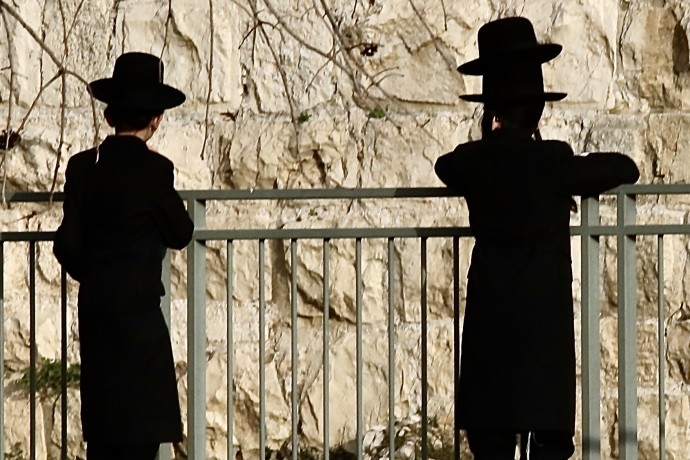Visiting Tel Aviv, Ramat Beit Shemesh, Gush Etzion and Jerusalem, one gets the impression that Israel is largely an English-speaking country, as there are so many English-speaking residents of all types in these locales.
This is true for secular students turned on to Israel by free introductory Birthright tours and more advanced Masa, Chabad and Olami programs, and is also true for the modern Orthodox crowd, to whom aliyah has always been important.
And it is increasingly true for English-speaking haredim as well, especially in Ramat Beit Shemesh and Jerusalem. This last group was the focus of the first-ever “Kehillah Summit” in Jerusalem last week, organized by Rabbi Yeshoshua Pfeffer of Jerusalem and his colleagues.
Addressed by some of the most respected names in the Israeli Anglo-haredi world (including Rabbi Asher Weiss and Rabbi Zev Leff) as well as respected former Jerusalem Post columnist Jonathan Rosenblum, the goal of this two-day conference was to help strengthen and organize the anglo-haredi community in Israel.
How large is the community? Let’s begin even earlier: how many “anglos” (the common shorthand for English-speakers) of all types are there in Israel?

Based on official numbers (and Wikipedia) , there have roughly been 140,000 American, 40,000 British, 20,000 Canadians, 20,000 South Africans, 5,000 Australians, 1,000 Irish and 1,000 New Zealanders immigrants, from 1948 to 2020. That totals 227,000 English-speaking immigrants throughout Israel’s history. Some of them are no longer alive; others are no longer in Israel.
However, add in a few thousand people since 2020 and we are likely talking about just over 200,000 English-speaking immigrants presently in Israel. Every year, approximately 4,000 more arrive.
How many of these immigrants are haredi? It is hard to know, for many reasons. Historically, this kind of thing wasn’t measured. Also, the word “haredi” is rarely used by the ultra-Orthodox populations in the diaspora and even has different connotations in different places. Even when the word is used, the definition is unclear. Who is black and white is... not always Black and White. There is much more of a range than one might realize.
Is a family haredi if both parents are working professionals, if the father wears colored shirts or if the kid goes to the army? Furthermore, not all haredi immigrants... immigrate, at least officially. Some have theological objections. Others come to learn Torah for years and end up staying... and just never bother to apply for citizenship.
According to my colleagues at Nefesh B’Nefesh, which is essentially responsible for aliyah from Anglo countries, roughly 70% of Western immigrants currently self-identify as religious, which includes both those from the national religious community and haredim.
How many are haredi?
No one really knows how many are haredi – but any visitor to Jerusalem or Beit Shemesh will quickly realize that the numbers are substantial, especially when one includes the children of Anglo immigrants: perhaps a community of 200,000, more or less? No one really knows.
WHATEVER THE number, the Anglo-haredi community’s significant size makes it possible to create a community organization to help respond to its specific needs. The roughly 150 men and women (separate seating, of course!) who joined the Kehillah Summit at the Ramada hotel in Jerusalem last week were focused on improving access to educational, mental health, professional and other services to the Anglo-haredi community.
As with any immigrant community, it has its own special needs: As a simple example, typical Israeli haredi schools are not always the right fit for American haredi families, many of whom are used to a more American educational system.
How does one navigate the system here? Speaker after speaker, and roundtable after roundtable, participants were hopeful and excited to build something needed and new.
What about the future? How much haredi aliyah can we expect?
Future haredi aliyah
A significant number of the roughly 4,000 Anglo immigrants to Israel every year are haredi (as the rapid growth of Ramat Beit Shemesh in particular shows). Is that number likely to grow? One speaker at the summit, Rabbi Yitzchok Adlerstein, director of Interfaith Affairs for the Simon Wiesenthal Center and professor of Jewish Law at Loyola Law School, expects tens of thousands of Anglo-haredim to make aliyah in the coming years, and possibly more.
Why? There are many reasons: Antisemitism in the West is real and growing, there are physical attacks on Jews every day and people simply feel less safe than in the past.
Furthermore, the great polarization of politics, the breakdown of American cities, increasing gun violence, the imposition of gender-identity education and the expanding presence of LGBTQ+ culture in popular society are causing some to speak of the demise of America. In other words, it seems like the push out of America is getting stronger.
Furthermore, the pull for haredim to come to Israel may be getting stronger, as well. It is the Holy Land, after all, and religious opportunities in terms of mitzvah observance and Torah study are unparalleled.
In the past, for the Anglo ultra-Orthodox community, there have been impediments to aliyah that often included finances, lack of educational opportunities they feel comfortable with, distance from family, and so on.
Today, much of this has changed. There are numerous anglo-haredi neighborhoods for those wanting a soft landing in a new country. Technology has made work and family togetherness much easier.
Additionally, there are a growing number of schools that have more of an Anglo-haredi feel and as the summit showed, there are dozens of valuable organizations servicing the community. In other words, it is now easier for Anglo-haredim to come to Israel than perhaps it ever has been, and they have more reason to come.
Based on the past, thousands will. How many? No one knows, but the kehillah (community) is ready for them.
The writer is an author and lecturer, and the co-founder of Mosaica Press.
